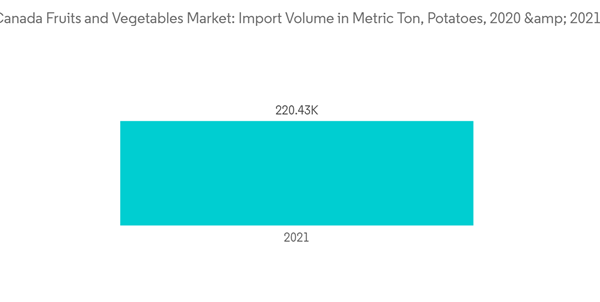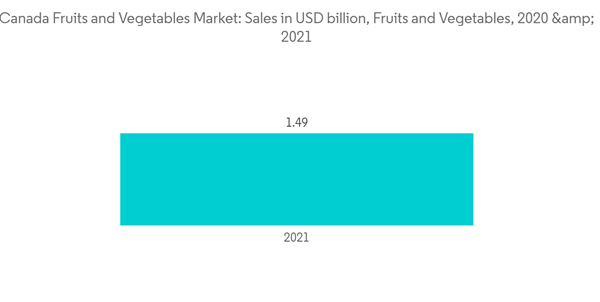Key Highlights
- The growing season in Canada is very short. Despite a relatively short growing season, Canadian farmers produce a wide range of fruits and vegetables, including apples, tender fruits, grapes, cherries, peaches, blueberries, cranberries, strawberries, and raspberries, and vegetables such as tomatoes, onions, spinach, lettuce, and asparagus, etc. According to the Government of Canada, in 2020, the production of carrots, onion, tomatoes, cabbage, and lettuce are some of the high-value crops, which accounted for 10.3%, 8.5%, 8.4%, 6.8%, and 6.3%. Similarly, beets, beans, peppers, and asparagus yield increased by 15.7%, 7.6%, peppers by 6.7%, and 6.4% in 2020.
- The demand for fresh produce has been increasing on a large scale because of an increase in healthier eating trends for consumers. Thus, the increase in health consciousness among the people is driving the market growth. Alongside this, the harsh climatic conditions and extreme cold climate may prevent production, restraining market growth.
- Moreover, Canada needs to gain more market share in North American fruits and vegetables. It accounted for 3.4% of the North American fruits and vegetable market. Though Canada is a small market for fruits and vegetables in North America, the market for fruits has grown by 4.1% and reached USD 878 million in 2020. This is majorly due to the increase in the country's exports of fruits. Similarly, the farm gate price for vegetables has grown for nine consecutive years since 2010. Thus, the increase in the market for fruits and vegetables favors the market growth during the forecast period.
Canada Vegetable & Fruit Market Trends
Increased demand for fruits and vegetables
- The rising population is the primary reason for the increase in the imports and number of fruits and vegetable markets in Canada. The population has been growing continuously in Canada. This is due to the increase in the number of immigrants in the country. For instance, according to International Monetary Fund, the population of Canada has been growing for several years and will reach 38.23 in 2021.
- Additionally, according to StatCan, the number of immigrants in Canada in the year 2021-2022 was 492,984, which is double in number compared to 2020-2021, in which only 226,329 immigrants entered the country. This population increases the demand for fresh produce in the country, mainly for fruits and vegetables.
- Along with this, the climatic conditions do not favor the production of fruits and vegetables from other countries. The country's production of fruits and vegetables is reduced due to its climatic conditions. For instance, according to the Food and Agriculture Organization (FAO), the production of blueberries decreased from 176,155 thousand metric tons in 2019 to 146,370 thousand metric tons in 2020. So, to attain self-sufficiency and to meet the increased demand, the country majorly imports fruits and vegetables.
- Furthermore, after the post-pandemic, the people in the country became more concerned about health, and the demand for fresh produce such as healthy fruits and vegetables has increased, increasing the market for fruits and vegetables. Potatoes are the far most important vegetable crop in the country. The production of the crop decreased in 2020 to 68,685 metric tons in 2019. This decrease in production gave rise to imports that grew from 168,113 metric tons in 2020 to 220,425 metric tons in 2021.
- Therefore, the increase in the demand for fruits and vegetables, along with the decrease in production, is giving rise to imports which cater to the market's growth in the forecast period.
Favorable Government initiatives in Fruits and Vegetable sector
- The consequences of climate change are widespread in the country and serve as a continual reminder of the need to take action. To solve agricultural problems that benefit the economy and the environment for future generations, the Government of Canada is assisting the fruit and vegetable industries through many initiatives.
- The Canadian government's Budget 2022 included several proposals to strengthen safeguards for agricultural employees and growers, simplify administrative barriers for dependable repeat employers, and guarantee that employers can promptly hire people to fill temporary labor market gaps. For instance, the budget for 2022 proposed allocating USD 16 million over two years, on a cash basis, starting in 2022-2023, to the Atlantic Canada Opportunities Agency through the Jobs and Growth Fund to support long-term investments and assist in stabilizing the Prince Edward Island potato sector and supply chain.
- Similar to this, budget 2022 also included a proposal to allocate USD 12 million over two years, beginning in 2022-2023, for the Canadian Food Inspection Agency to quicken its investigation into the most recent discovery of potato wart to help prevent its spread and to enable the earliest possible return of full trade with the United States. The past two years have been particularly difficult for Canadian farmers because of the COVID-19 outbreak, catastrophic natural disasters, and severe supply chain disruptions.
- Despite all this, the fruit and vegetable industry has persevered and kept putting healthy food on Canadians' tables across the nation. Hence, the government taken initiatives are expected to improve the productivity and the quality of fruits and vegetables.
- Moreover, a new foreign labor program developed and funded by the Canadian government in 2022 for agriculture is expected to maximize the employment of Canadians and permanent residents. Under this program, USD 48.2 million was allocated over three years, with USD 2.8 million remaining amortization. The program will be regularly reviewed by the Minister of Employment, Workforce Development, and Disability Inclusion for its impact on local labor markets.
- Such initiatives are expected to boost the local fruit and vegetable growers to actively participate in growing during the forecast period. Additionally, this type of initiative boosts fresh fruits and vegetables sales. For instance, according to Statistics Canada, the sales of fruits and vegetables have been increasing since 2018 and will reach USD 1.47 billion in 2021. Therefore, the increase in the sales of fruits and vegetables contributes to the market's growth in the forecast period.
Canada Vegetable & Fruit Industry Overview
Additional Benefits:
- The market estimate (ME) sheet in Excel format
- 3 months of analyst support
This product will be delivered within 2 business days.










